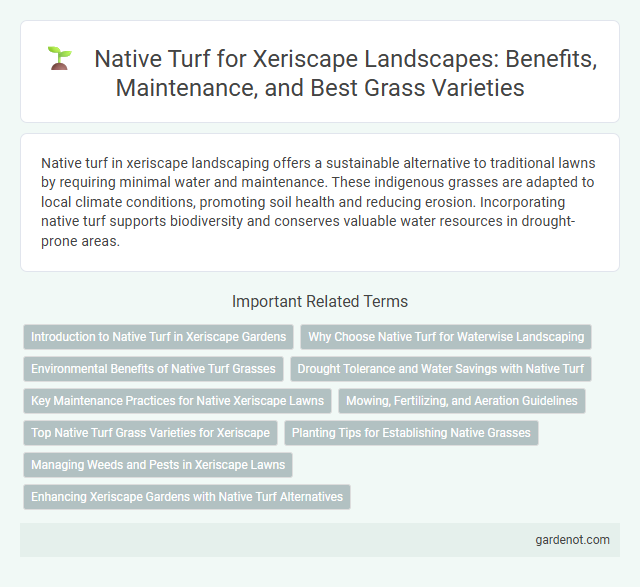Native turf in xeriscape landscaping offers a sustainable alternative to traditional lawns by requiring minimal water and maintenance. These indigenous grasses are adapted to local climate conditions, promoting soil health and reducing erosion. Incorporating native turf supports biodiversity and conserves valuable water resources in drought-prone areas.
Introduction to Native Turf in Xeriscape Gardens
Native turf grasses in xeriscape gardens offer drought-resistant, low-maintenance ground cover well-suited to arid and semi-arid climates. These grasses, including buffalo grass (Bouteloua dactyloides) and blue grama (Bouteloua gracilis), naturally adapt to regional rainfall patterns, reducing or eliminating the need for supplemental irrigation. Incorporating native turf enhances soil health, supports local biodiversity, and conserves water resources while maintaining the aesthetic appeal of green outdoor spaces.
Why Choose Native Turf for Waterwise Landscaping
Native turf enhances waterwise landscaping by requiring significantly less irrigation compared to traditional grasses, promoting sustainable water conservation in drought-prone regions. These grasses are naturally adapted to local climate and soil conditions, reducing the need for chemical fertilizers and pesticides, which lowers environmental impact and maintenance costs. By choosing native turf, landscapes achieve a resilient, aesthetically pleasing lawn that supports local ecosystems and conserves vital water resources.
Environmental Benefits of Native Turf Grasses
Native turf grasses improve water conservation by requiring significantly less irrigation compared to non-native varieties, reducing overall water usage. Their deep root systems enhance soil health by preventing erosion and improving nutrient cycling, which supports local ecosystems. These grasses also provide habitat for native wildlife, promoting biodiversity and ecological balance in xeriscape landscapes.
Drought Tolerance and Water Savings with Native Turf
Native turf grasses such as Buffalo grass and Blue Grama exhibit exceptional drought tolerance, requiring up to 50% less water than traditional lawns. These native species adapt to local climate conditions, reducing irrigation needs and promoting significant water savings in xeriscape landscaping. By incorporating native turf, homeowners achieve sustainable, low-maintenance lawns that conserve water during dry seasons.
Key Maintenance Practices for Native Xeriscape Lawns
Native turf in xeriscape lawns requires minimal watering techniques that align with regional precipitation rates, reducing overall water consumption. Mowing at higher blade heights promotes deeper root growth and enhances drought resistance, while periodic aeration improves soil structure and nutrient absorption. Implementing targeted fertilization schedules using slow-release, organic fertilizers supports native grass health without causing nutrient runoff or excessive growth.
Mowing, Fertilizing, and Aeration Guidelines
Native turf in xeriscape landscapes requires minimal mowing, typically limited to 2-3 inches in height to promote healthy growth and reduce water loss. Fertilizing should be done sparingly with slow-release, low-nitrogen formulations to support drought tolerance without excessive nutrient runoff. Aeration is recommended once a year to improve soil oxygen levels and enhance water infiltration, ensuring deep root development while conserving moisture.
Top Native Turf Grass Varieties for Xeriscape
Top native turf grass varieties for xeriscape include Buffalo grass, Blue grama, and Bermuda grass, all known for their drought tolerance and low water requirements. Buffalo grass thrives in warm climates and requires minimal mowing, while Blue grama offers deep root systems that enhance soil stability and conserve moisture. Bermuda grass adapts well to various soil types and recovers quickly from stress, making it ideal for sustainable, water-efficient landscaping.
Planting Tips for Establishing Native Grasses
Selecting native turf varieties such as buffalo grass or blue grama enhances drought tolerance and minimizes irrigation needs. Plant seeds in early spring or fall when soil temperatures are optimal for germination, ensuring consistent moisture during establishment. Regularly mow at higher heights to promote deep root growth and reduce weed competition, fostering a resilient native grass lawn.
Managing Weeds and Pests in Xeriscape Lawns
Native turf grasses in xeriscape lawns naturally resist many common weeds and pests due to their adaptation to local climate and soil conditions. Integrated pest management techniques, such as manual removal and targeted biological controls, effectively minimize chemical use while maintaining lawn health. Regular monitoring and proper lawn maintenance, including appropriate mowing and watering schedules, also contribute to controlling weed proliferation and pest infestations.
Enhancing Xeriscape Gardens with Native Turf Alternatives
Native turf alternatives enhance xeriscape gardens by reducing water consumption and supporting local ecosystems. Drought-tolerant grasses like Buffalo grass and Blue Grama create sustainable, low-maintenance ground covers that thrive in arid climates. Incorporating native turf improves soil health and provides habitat for pollinators, strengthening ecological balance in xeriscape designs.
Native turf Infographic

 gardenot.com
gardenot.com